How to Start Your Freelance Career in 2024 and Thrive
Running a business and working independently sounds nice, sure, but the road to complete freedom and setting up your own schedule is often bumpy and a lot less glamorous than you’d think. If you are trying to make it on the freelance market—this is definitely something to keep in mind.
First, you want to find your niche. Then, you’ll need to land your first client. However, this is not where your job ends, because working with just one client is usually not enough when you’re a freelancer. Most of the time, you’ll have to expand your base and juggle multiple clients, i.e. if you want to reach your financial goals.
And when you set up everything, you’ll need to think of invoices and taxes—in short, the less exciting aspects of freelancing.
Plus, we haven’t even touched upon the management and organization side of things.
If being a freelancer doesn’t sound so tempting anymore, don’t worry. Once we go through our in-depth guide to freelancing, you’ll have a clearer picture of how to start, manage, and organize your entire freelance business and finally create the lifestyle you love.
Are you truly willing to put the effort into becoming your own boss and withstand whatever it takes? Let’s do this together then!
Pros and Cons of Being a Freelancer
Before we go into any further detail on how to become a freelancer, let’s go over the main pros and cons of being a freelancer in this day and age:
Pros
- Being able to do what you love,
- Having full control over your schedule, work hours, and work location,
- Choosing who you want to work with/working with diverse clients,
- Massive earning potential (some freelance experts offer their services at very high rates),
- Casual attire,
- No commute.
Cons
- Inconsistent cash flow (not necessarily),
- Filing your own taxes,
- No paid time off, maternity leave, and insurance,
- Juggling multiple clients,
- Running every aspect of business,
- Feeling isolated.
Now that we’ve got the pros and cons out of the way, and you are still thrilled about the idea of starting a freelance business, then keep on reading.
What Kind of Freelance Work You Can Do?
Here’s a list of highly lucrative freelance business ideas that can land you your first client within just a few days (provided you have at least basic knowledge in one of these industries under your belt):
- Developer,
- Designer,
- Data analyst,
- Virtual manager,
- HR manager,
- Copywriter,
- Videographer,
- Customer Support Agent.
Where to Find a Job as a Freelancer?
How to become a freelancer? Get your foot in the door! Nowadays, there’s plenty of platforms where you can find a job as a freelancer and fast track your dream career, with some of the most popular ones being:
- Freelancer,
- UpWork,
- Guru,
- 99Designs,
- Fiverr.
If you have no luck with the platforms, you can also give freelance job boards a try. Most of them are free to use, don’t require any signups to apply for a job and you don’t need to give a huge chunk of your earnings to them. The competition on these boards is lower than with the platforms mentioned above and clients are willing to pay more for top-notch service and hire you long-term.
However, as a beginning freelancer, you might have a hard time finding your first gig here, and you should do your best to get the client’s attention when applying.
What are the best freelance job boards?
- Indeed Remote Jobs,
- FlexJobs,
- Jooble,
- LinkedIn Job Search,
- Simply Hired,
- Remote.co,
- RemoteOK,
- Angel List,
- Monster,
- RemoteTechJobs,
- Creative Heads (for animators and video editors),
- Remotive (best for designers, marketers, and developers),
- ProBlogger (for writers and bloggers),
- Smashing Jobs (for web and graphic designers).
When applying for a job on one of these boards, you should send along a proposal as well. So, how do you write proposals that stand out?
- Introduce yourself, what you do, how much you charge, but still keep it short (2-3 sentences).
- Break down your prospect’s problem and do your best to let them know you understand their pain points.
- Offer a solution and outline the strategy about how you can help them overcome obstacles.
- Balance the benefits and the price of your service, making sure the client sees the value you bring to the table is multiple times higher than what they should invest.
How to Create a Portfolio and Land Your First Client as a Freelancer
In the world of freelancing, having an outstanding portfolio is crucial if you want make a strong impression. The great news is that you can create a superb, enticing portfolio even if you don’t have a myriad of projects under your belt, and this is how.
1. Create a Portfolio
Your portfolio should demonstrate your skills and what kind of job you are great at. If you are a graphic designer or illustrator, sketch up some fancy icons. If you are a copywriter, craft an offer clients can’t refuse. If you are a developer, code up your own website.
Or, you can use one of the following websites to put together an attractive and professional portfolio:
- Behance (free),
- Carbonmade (offers a free account),
- Dribble (free),
- Coroflot (for designers, free),
- Canva (has a free version).
2. Flaunt Your Strengths
An impressive portfolio, packed with a collection of projects you’ve worked on is not likely to land you a gig if you don’t add the necessary details clients and hiring managers should know about.
Instead of just bragging, make sure to make it clear what you can do to make the client’s life easier. Can you double their conversions? Or get their emails opened? Let them know which value you bring.
Explain in-depth the work you provide. Show them some social proof or include testimonials of clients and companies you’ve worked for.
Pro Tip: If there are only a few projects in your portfolio, explain what you did on each and include challenges you worked through to give clients a better idea of what working with you feels like.
Also, tell the world more about your work preferences and answer some of the most common questions someone hiring you might have (work hours, pricing, etc.). Lastly, make it simple for clients to get in touch with you. Make your email address and phone number easy to find, and include links to your social media profiles.
3. Create a Free Resource
Give away some of your work for free to prove to your clients you’re truly passionate about what you do when you’re just starting a freelance business. This tactic can peak your potential employers’s interest and make them more interested in what you do.
How Do You Set Prices as a Freelancer?
Should you price by the hour or per project, and how much? Most newbie freelancers struggle with these questions as much as they do with landing their first clients. It all depends on how much you value your skills and your time. Remember that the price you charge sends out a clear message to your client. The lower the price, the lower the quality. Most clients have this mindset.
On the other hand, you shouldn’t overprice yourself either, especially if you are just starting out. How much would you get paid for that job if you worked in a company? Charge the same amount + a little bit extra (handling multiple aspects of a business on your own comes at a price).
Bonus tip: Clients care most about quality, not the time you invest in a project. Sometimes, you’ll need 2-3 hours to deliver work, sometimes it’s going to be 2-3 days, or even 2-3 months. Don’t value your work by hours but the value you can provide for the client. This way, you’ll work less and get paid more.
Do You Need a Freelance Business Plan?
Now, you might be thinking freelance + a business plan don’t go hand-in-hand. They don’t, if you just want to make some extra cash. But, if you want to make a living and thrive, you’d better have one.
You might also need a freelance business plan if you don’t have anything on your plate and feel anxious and stressed or overwhelmed with the amount of work on the other hand.
Incorporate your freelance strategies into your business plan, see how each works, prioritize work, professionalize and grow your freelance business.
What Should a Freelance Business Plan Include?
1. Summary and Purpose
This is your chance to shine! Tell a short, introductory story about your freelance business, claim a purpose—what you want to achieve and why—and set clear values (f.e. discipline, productivity, credibility, trust, fame), as well as priorities.
2. Product/Service Description
What are you good at? What do you have to offer? Are you an event photographer? Or a commercial one? Are you a freelance translator? Which languages do you know? Are you a product or graphic designer? List everything you have to offer that can solve your potential clients’ problems and concisely outline the process you usually follow.
Do you work per project or have standard packages? What does each include? Include your pricing, a number of free revisions, and rush fees to your freelance business plan.
3. Competitor Analysis
Competition is tough in the freelancing world. Yet, you can’t stand out if you don’t know your competitors well, including companies, agencies, and other freelancers. Do some research on how they are doing things, write this down in your freelance business plan, and figure out ways to do these things better. Always think about the added value you can provide to clients your competitors do not offer and use it as your unique selling point.
4. Ideal Buyer Persona
Create a fictional character of an ideal buyer. Go deep into this—give them a name, define what industry they are in, what their pain points are, how they find you, etc. Even better, create a list of similar buyer personas, get deep into their profiles and problems, and come up with solutions for these problems.
5. Client Acquisition and Management Plan
Let’s face it: you’re nothing without clients. However, building a stable client base is not as easy as it may seem. If you want to turn your clients into repeating customers and ensure a steady income, do your best to build their trust and loyalty.
First, you have to find clients, connect with them, then figure out what’s hurting their business, and finally come up with a suggestion that can solve their issues. Remember all the job boards we mentioned in the previous paragraphs? Pick your favorites, tuck them somewhere in your business plan to make them accessible at a click, check on new job postings every couple of days, and, of course—apply for the positions your profile matches with.
Finding a client is not the end of the road for you, though. Your ability to keep clients happy is key to long-term growth. If you can provide consistent results, clients will keep coming back for more.
However, working with multiple clients can be daunting. Just like you created your ideal buyer, you can create an ideal client profile and incorporate it into your business plan. With time, you will become more selective and start filtering out clients that are not your cup of tea or that are not paying you enough.
6. Goals and Milestones
Set clear goals and tie them to a specific time frame. For example, set your revenue target at $10,000 and a timeframe (5/6 months). Determine how much you should charge or how many clients you need to get, then set milestones to make your goal easier to accomplish. Get specific as you can—get 100 followers on Instagram/make 100 connections on LinkedIn, get 1,000 website visitors in a month, send 10 proposals per week, etc.
Always ask questions on how to achieve goals in even less time than you’ve set. Would advertising on Google and social media help you grow your freelance business faster?
7. Marketing and Sales Strategy
Decide which marketing strategy you want to give a shot (blogging, social media, direct emailing), claim that in your freelance business plan, and invest your time each day on implementing it. Whether it be publishing one blog post or video per week, cold emailing 5 prospects a day, or creating content for Facebook and Instagram, stick to the schedule. Write down what’s your starting point, keep records on how much traffic/followers/subscribers you are getting, and compare results after 3 to 6 months.
8. Financial Plan
A financial plan is a crucial element of every business plan, not just your freelance business plan. You should find a way to utilize your budget and prioritize where you’re going to invest. If you plan to advertise on Google and social media, note that it could require a bit of an investment.
On the other hand, your marketing efforts can give you massive returns but you should track both investments and gains and write them down in a separate section of your freelance business plan.
Needless to say, if you’re not that good or familiar with financial planning, hiring an accountant or a bookkeeper would be a smart idea.
How to Set Up a Freelance Business Plan in Infinity
Not sure how to set up a successful freelance business plan? We’ve got your back when it comes to planning every step of the way. Down below, we’ll show you how to set up your business plan in Infinity, with real-life examples to make things easier.
1. Load the Business Roadmap Template

Just because you are running solo, it doesn’t necessarily mean you can’t run a project. Planning every aspect of your freelance business is a project, too! In Infinity, you can choose between 50+ templates and load the whole structure or customize it to your needs. You can also load the desired template right from your Infinity’s workspace. Or, you can import it from Trello or build it from scratch in a few clicks—you’re the boss.

2. Tell a Story About Your Freelance Business in a Separate Folder
Remember how it all started. New beginnings are always inspiring. Tell a story about how you got into freelancing, what were your main challenges, etc. Know the art of storytelling, whatever your expertise is. Whenever applying for a job, a prospect will ask you about how you started freelancing. The “why” you started, the early days of your freelance business, your values and mission—that’s how you get the client hooked. Here’s an example of how you can outline it in Infinity.

3. Describe Your Services in Detail
What do you offer to clients? Be specific about the services, tools that you’re using, explain the exact steps you take to deliver the most value to the customer, and put it all together in a separate folder.
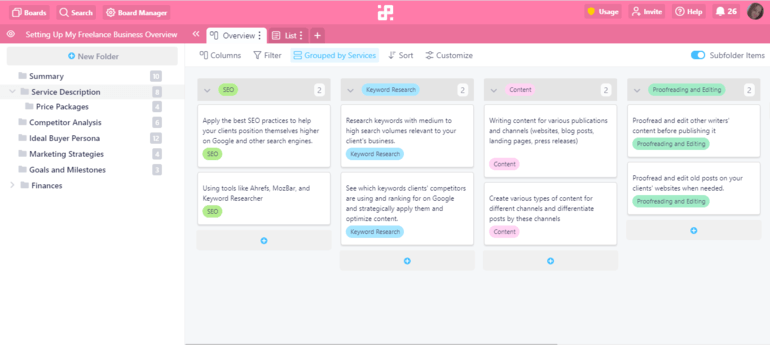
Do you charge per project, what are your hourly rates—you can outline your pricing strategy in Infinity as well. Once you’ve created the service description folder, you can create a subfolder to set your service pricing clear.

4. Analyze Your Competitors
Do some competitor research to see where you can position yourself on the market. See what your competitors’ unique selling propositions, strengths, and weaknesses are to get a clearer image of where you stand. Can you offer something extra to clients? Is there something you can do to transform YOUR weaknesses into strengths?
Load Infinity’s Competitive Analysis template right from your board and customize its structure so you are able to compare competitors and their products/services to yours. Having all this info in one place can help you act faster and get clients even faster.
Here’s a quick glance on how you can store and organize data about your rivals in Infinity and use it to position yourself better on the market.

5. Create Detailed Buyer Personas
Do you know who your ideal buyer is? What do they look like, how old are they, what their business and pain points are? Instead of writing all this down on paper, create several ideal buyer personas in Infinity, just like this.
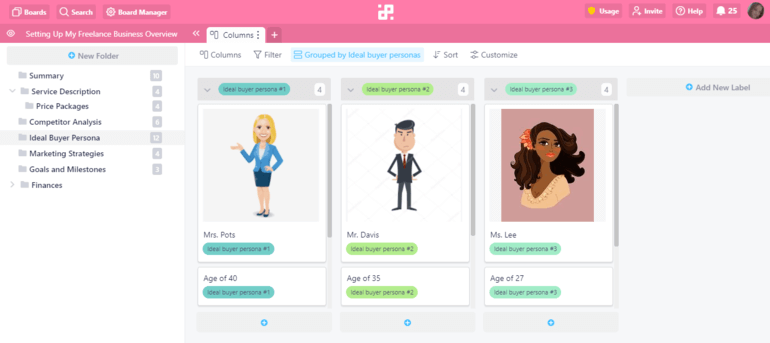
Infinity lets you add multiple attributes to each item on your lists, including images, links, checklists, etc. This is where you can get creative. When defining your buyer persona, you want to picture that person—what they look, how old they are, their occupation, maybe even their marital status. Here’s just an example of how you can define your ideal customers using Infinity.

6. Plan How You’re Going to Advertise Your Freelance Business
If you don’t tell the world about your freelance business, how do you think you are going to get clients? In Infinity, you can outline your marketing strategy for various channels—your website and all the social media you’re on.

Not only can you outline your strategies, but also plan concrete steps for them. Remember how we mentioned checklists? Checklists are the best way to break down larger initiatives into smaller ones. Divide major tasks into more manageable ones and you’ll grow your online presence before you say knife.
Not only can you divide tasks into subtasks, make checklists and tick off subtasks as you complete them but you can also evaluate their impact and effort required to complete them and track progress via progress bars.
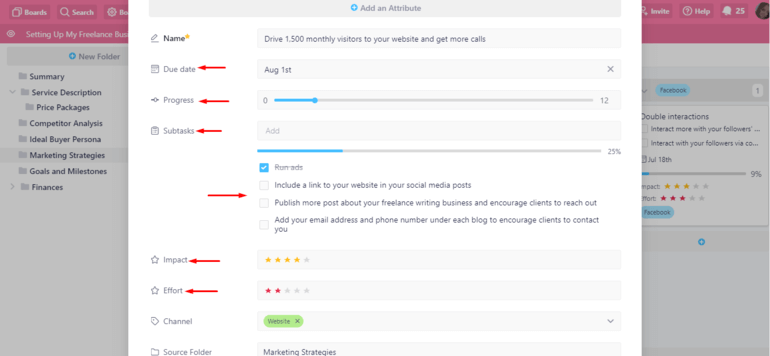
7. Set Ambitious Goals and Crush Them
There’s no point in setting up a business and having no clue where you want it to take you, or what you can do to grow it and your finances, of course. Supporting the popular Kanban methodology, Infinity lets you create tasks and follow them to their completion. Whether it be reaching a specific financial goal or taking steps that help you lower taxes, you can map it all out in Infinity.
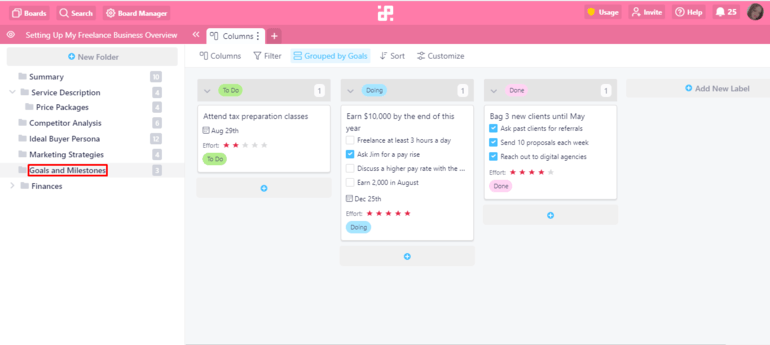
8. Manage Your Invoices
The most fun part of any business is—getting paid. Although managing invoices is not that interesting, you still have to do it if you want to get that money flowing. Again, Infinity can offer a helping hand with our Invoice Management template.
Did we tell you that you can load a template into a template with Infinity? Now tell us, how cool is that? Simply create a new folder and load the desired template from our library or import one from Trello.

Load and customize our freelance invoice template to reduce those frustrating administrative tasks and take care of your finances in a single directory. The best thing is that you can attach invoices, check their status (sent/paid), enter the amount of money clients should pay for your services, the type of service, due dates, and more.
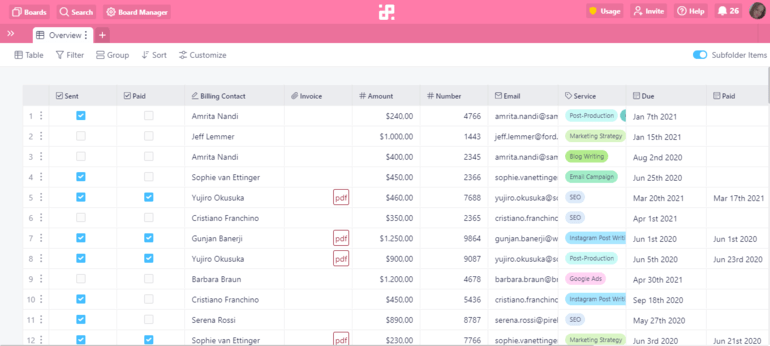
Now that you have a better grasp on how to become a freelancer and how to set up a freelance business plan, we want to bring you a closer look of how you can organize and manage your freelance business in Infinity as well.
How to Organize Your Freelance Business in Infinity
In Infinity, you can set up a plan for running your freelance business, but also organize every aspect of it—tasks, clients, finances, track important metrics, and everything in-between, and here’s how.
1. Load the My Freelance Business Template
Instead of crafting a template on your own, load our dedicated My Freelance Business Template that offers a myriad of customization options. You can keep all the items or delete the whole structure and build up your own.
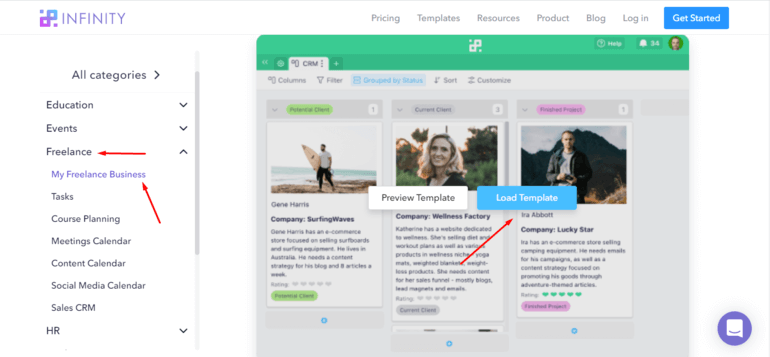
2. Bring All of Your Projects Under One Roof
Things are going well, you’ve landed a couple of clients already and completed a few projects. How do you separate the ongoing projects from the ones you’re currently working on and the ones you have successfully delivered?
Create a folder to bring all your clients and projects to. Assign date, rating, status, and client attributes to each to make them easier to group. This way, you’ll get a perfectly clear overview of what you’re on at the moment and potential opportunities for new work. Here’s how it all looks like in Infinity.
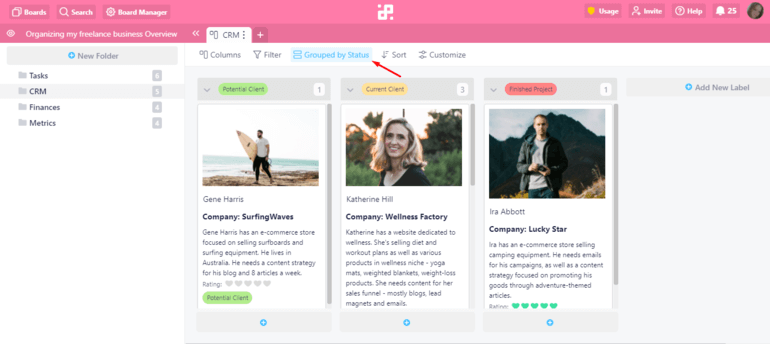
3. Create a Dedicated Folder for All of Your Tasks
Being a freelancer, you are probably juggling clients and tasks. Infinity allows you to neatly organize workloads so you’re never behind schedule. Whether you are going to group items on your board by client, social media channel, website copy, date, or any other attribute, Infinity’s flexibility has you covered.
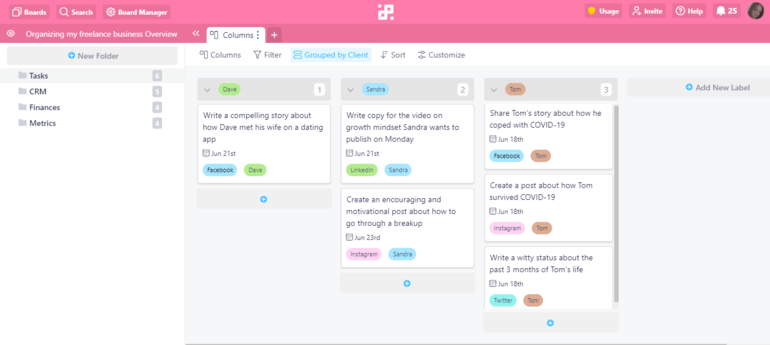
Infinity lets you view your items in several ways (6 to be precise). Have your tasks displayed on a calendar to get a full insight into your workflow so you can know whether you can take on more work.

4. Keep Track of Your Monthly Earnings
How can you tell how successful you are at what you do? By how much you earn. With Infinity, you can easily track your finances and see whether your cash flow is truly flowing or degrading. Write down how much money you’ve earned for each of the past 3-6 months, compare results, and track your business’ profitability with ease. Again, you can load our freelance invoice template to your board to keep track of your recieveables, payment dates, etc.

5. Keep An Eye on the Metrics
Another way to tell whether you are running your freelance business successfully or not is to track key metrics—the number of proposals you sent, the number of interviews you got invited to, closed deals, money earned, etc.
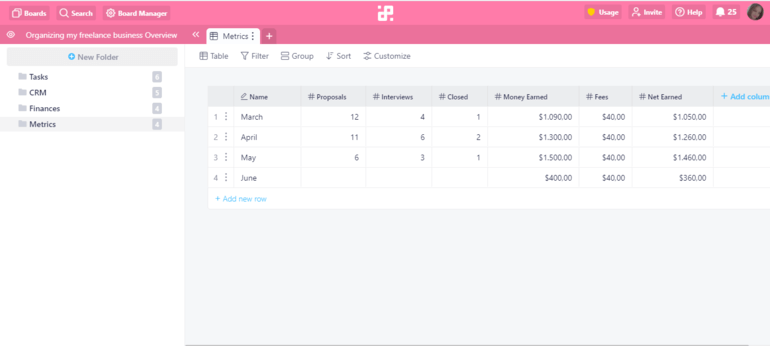
On the other hand, if you are trying to build a social presence and position yourself higher on the market and attract more clients, in Infinity, you can track your social media and website metrics as well. Create a subfolder (see below), write down metrics you want to track and sort them by months to see how far you’ve come. This can also help you see whether your marketing strategies are doing well or would need some adjustments.

Bonus Tips on How to Organize Your Freelance Business
1. Don’t take upon yourself more than what you can handle
When starting out a freelance business, you will be in desperate need of clients. But when they finally start trickling in, you could easily fall into a trap and commit to more work than what you can handle. Accept offers you are truly interested in and the ones you feel are fair expectations in pay. That’s the only way to produce quality work, otherwise—you and your business will suffer. Think quality, not quantity.
2. If possible, stay away from one-time deals
When doing a freelance job, you’ll be offered short-term jobs once and then. Although some money is better than no money, we highly advise you to make more strategic decisions on the jobs you take. The goal is to build long-term relationships and have steady clients (read: steady and reliable income).
3. Take the necessary steps to make sure you get paid for your work
The Probably the most stressful thing about freelancing is the uncertainty of getting paid after you deliver work. Follow these steps to ensure you are always paid in a timely manner:
- Do some research to make sure your client is legit,
- Agree on payment terms in advance and include them in your contract,
- Always ask for a deposit (10-20%),
- Add all the relevant data to your invoices,
- Use milestone payments,
- Charge late fees on overdue payments.
Conclusion
Now that you know how does it look and what it takes to start, organize, and grow a freelance business, it’s up to you to build up on your skills (writing, design, coding, etc.) and map out your strategy. And to make things smoother, Infinity’s here to give you a helping hand along the way.
Whether you create something entirely on your own or load one of our templates, we’d be thrilled to hear and see what you’ve done. Feel free to get in touch and share your ideas with us—we’re just an email or a chat away,















